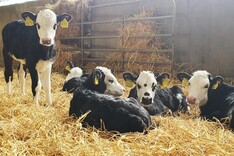Dairy Beef Calves
This week marks the start of some of the big calf sales in the south of the country. Some farmers are contemplating a system switch to dairy calf-to-beef, however, margins need to be looked at closely.
While dairy X calves are cheap to get into, they can be expensive to bring to finish. Margins are tight and efficiency levels need to be high. Do the sums before purchase and see what you can afford to pay for a calf.
Current calf prices seem high for a beef farmer to make any money. Early calf sales in the south have started very strong, with reports of AAX and HEX calves making in excess of €350/head at some marts, with farmer buyers in abundance.
While prices in early January are always high, it is impossible to say what the price of calves will average this year.
Before you commit, it is vital that you do a budget. While a calf-to-beef system is relatively cheap to get into, most systems require about €900 to €1,000 in working capital per head from purchase to slaughter, so budget carefully.
Sit down and work out how much you can afford to pay for a calf and if they are too expensive, hold off buying. As more and more calves come out, prices will fall, so don’t panic buy.
Make sure you have the right facilities and make sure you are buying calves based on their Commercial Beef Value (CBV). This CBV value will be displayed on mart boards for calves registered through the new DNA calf registration service.
In a trading system, it’s all about the buying and selling price. You have some control over what you pay for calves, so don’t blow the budget on the first day out.
Night feeding
Feeding cows late in the evening has been shown to increase the number of daytime calvings on some farms. This can be a big help in reducing night time calvings when help is scarce.
To work best, the cow needs to be fed her daily allowance of silage in the late evening. Farms using this method successfully feed at night for 3-4 weeks pre-calving.
Pre-calving minerals
All in-calf spring calving cows should be supplemented with minerals for six to eight weeks prior to calving. Every year I hear of farms that encounter high mortality in calves or retained placentas, and when looked into, it points to mineral deficiencies.
Silage can be analysed for minerals and a specific mineral make up, but most minerals that are available to buy will cover a suckler cow’s needs. Keep an eye on price, but don’t be penny wise and pound foolish and make sure it has good levels of essential trace elements like copper, selenium, cobalt and iodine.
Calcium should be at 0% in a pre-calving mineral. Where there have been problems on the farm in the past, get the vet to take some blood samples from cows pre-calving to determine mineral profile and make changes to the feeding programme based on these results.
If feeding powdered mineral on top of silage, feed twice daily and make sure there is adequate space for each cow to eat at the same time. It is recommended to have 0.5-0.66m (1.5-2.0ft) worth of feeding space per cow.






 This is a subscriber-only article
This is a subscriber-only article










SHARING OPTIONS: